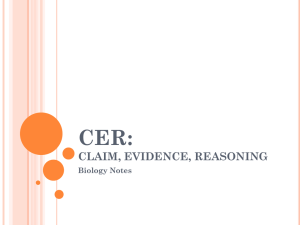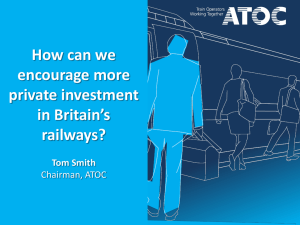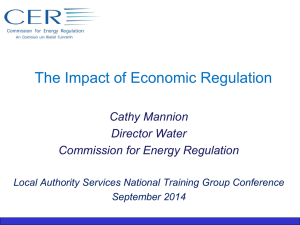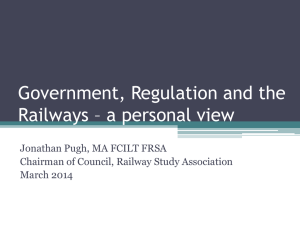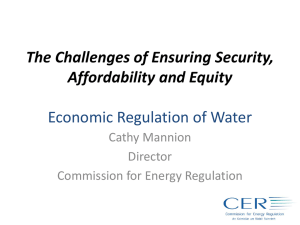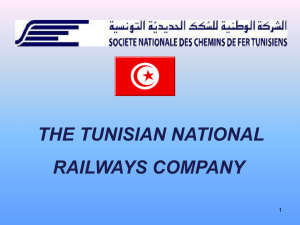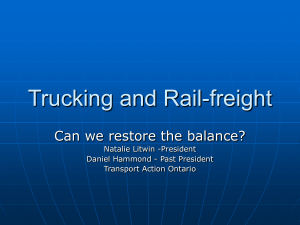CER - Hungrail
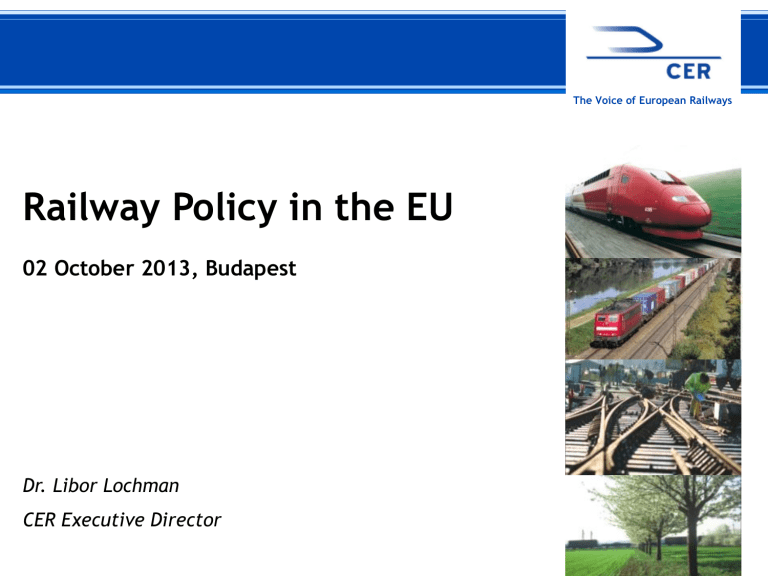
Railway Policy in the EU
02 October 2013, Budapest
Dr. Libor Lochman
CER Executive Director
02 October 2013 1
The Voice of European Railways
CER
CER – Representing European railways in Brussels
CER stands for…
The Community of European Railway and
Infrastructure Companies brings together railway undertakings and infrastructure companies from the European
Union, Norway and Switzerland, the EU candidate countries as well as from the
Western Balkan countries
CER is based in Brussels and represents the interests of its members to the European
Parliament, Commission and Council of
Ministers as well as other policymakers and transport actors
CER’s main focus is to to support an improved business and regulatory environment for European railway and railway infrastructure companies.
02 October 2013 2
The Voice of European Railways
CER
What CER represents…
The Voice of European Railways
CER represents 80 member companies (23% privately owned), incumbents and new entrants, passenger and freight operators, integrated and separated infrastructure managers.
CER does not only represent the incumbent and system operators’ perspective but the largest membership of rail industry actors throughout Europe including service providers and a large number of independent infrastructure managers.
Breakdown of integrated and nonintegrated
CER companies
02 October 2013
Break-down of nonintegrated
CER companies
3 CER
CER interlocutors
The Voice of European Railways
Council
European
Railway Agency
ERRAC
European
Commission
TEN-T Agency
Social Dialogue
European
Parliament
ERTMS corridors
…
02 October 2013 4 e.g. AAR, CIT, EIM, OSJD,
OTIF, RNE, RŽD, UIC,
UNIFE, X-Rail, et al.
World Bank, EIB, UNECE et al.
CER
02 October 2013
The EU rail acquis
The Voice of European Railways
5 CER
The EU rail acquis (1)
International freight market opening
Accounts separation
Establishment of RB
Compulsory NSs
MACs
1 st
Railway
Package
Opening int’l and domestic freight mkt
Establishment of ERA
Interoperability directives
2 nd
Railway
Package
The
Trans-
European
Network
Public
Service
Transport
State Aid
Guidelines
3 rd
Railway
Package
Working conditions of crossborder mobile workers
The Voice of European Railways
Opening int’l passenger market
Rail passenger rights
Certification of train drivers
Environmental noise
Diesel emissions
Environmental liability
02 October 2013
Public procurement
Environmental legislation
Safety directive
(revision)
6 CER
The EU rail acquis (2)
Reinforced accounts separation
Independence of IM’s essential functions
Longer and stronger MACs
New principles for TACs
NDTACs and ETCS TACs
Access to Rail Related
Services
The Voice of European Railways
Rail freight corridor regulation
Eurovignette
Passenger rights on all modes
Recast of the 1 st railway package
New TEN-T and CEF
State Aid
Guidelines
02 October 2013
Governance of the rail companies
Domestic rail market opening
New ERA regulation
Interoperability
Safety
7
4 th
Railway
Package
CER
02 October 2013
The Voice of European Railways
Setting the conditions right: the rail system as it should be as a result of the Recast of the
First Railway Package
8 CER
The rail system: input, output and regulatory monitoring
2.2
€
MACs
PUBLIC AUTHORITY
3
€
The Voice of European Railways
1
€
2.1
PSCs
02 October 2013
Infrastructure
Manager
Access to infrastructure
Operators
€
€
Track Access
Charges
Infrastructure
Operators
4
CUSTOMERS
€
9
Infrastructure
Manager
€
Road Access
Charges
CER
Establishing the right public bodies and ensuring investments
1
The Voice of European Railways
For the satisfaction of the customers passenger or freight forwarders - States must guarantee an efficient functioning of the system
Establishing a Rail Regulatory Body
Establishing a Safety Authority
Ensuring good quality for both the rail network and the rolling stock of SOEs
Bearing in ming that the rail network (as the road network) relies on the availability of public money !
02 October 2013 10 CER
Public Service Contracts: undercompensation in CEE
& SEE
The Voice of European Railways
2.1
02 October 2013
Public Service Contracts must be stipulated on a commercial basis and remunerated according to the agreed terms!
11 CER
Multi Annual Contracts
The Voice of European Railways
2.2
States must stipulate Multi Annual Contracts
(at least 5-year long) with the infrastructure managers
To guarantee solid financial basis for maintenance and operations
To guarantee a medium-term horizon to plan new investments
To guarantee that profit and loss accounts balance incomes with expenditure
02 October 2013 12 CER
Fair intramodal competition
3
The Voice of European Railways
States must make sure to put in place an institutional framework which preserve a fair intramodal competition
Adequately staffing the Rail Regulatory Body
Guaranteeing the independence of the essential function of the infrastructure managers: path allocation and infrastructure charging
02 October 2013 13 CER
Fair intermodal competition
4
The Voice of European Railways
States must make sure to put in place an institutional and legal framework which preserve a fair intermodal competition
Putting enough resources at disposal, and in a fair way
Establishing a fair policy of charging for the access to respective networks
Making sure each modes‘ costs reflect all negative externalities
02 October 2013 14 CER
02 October 2013
The Voice of European Railways
The Fourth Railway Package
15 CER
4RP – The three main components of the intramodal competition
The Voice of European Railways
1
Additional competences for ERA
on authorisation for putting rolling stock in place on safety certification for railway undertakings
2
Opening the domestic rail passenger market
will define minimum scope of open access and maximum scope for PSO will propose compulsory tendering of PSO with only limited exceptions
3
Railways’ organisational structures
Universal imposition of separation
Transitional period where Annex V type of criteria shall be respected
Separate board members for holding and daughter companies
Long cooling-off periods for board members entrusted with the management of essential functions
New conditions for appointment of management board of essential functions
Consultative body of infrastructure users to be established
Network of infrastructure managers to be established
IMs to be reinforced, always covering the functions of infra development, maintenance, operations, marketing and charging
02 October 2013 16 CER
Interactions between open access services and Public
Service Obligations: a careful balance
The Voice of European Railways
Open access should apply on the entire network in every EU Member
State, provided that PSO economic equilibrium is preserved
Where open access and a PSO overlap on the network, States may take measures to safeguard the economic equilibrium of the PSO
Conversely, open access operators should also be protected – e.g. where a new PSO is created or the scope of an existing PSO is extended
Bundling of viable and non-viable services into single PSO/franchise contracts must remain possible for efficiency reasons
Ensuring that national Regulatory Bodies have all means to fulfil their responsibilities , also by a better coordination at EU level
And:
Financial architecture of national rail sectors must improve
Social conditions must be addressed
Deepening technical alignment between national rail sectors
02 October 2013 17 CER
CER view: the structural models
The Voice of European Railways
Efficient, non-discriminatory access to infrastructure – a major enabler of competition in the rail sector
Can be achieved with a well-financed and independent regulatory body
Allow efficient structural models to support competitiveness agains other modes
Both integrated and separated models can perform
confirmed by the recent EVES-Rail study results
Each Member State should be empowered to
reconsider its existing rail sector model
have sufficient flexibility to reform the given model switch between models, if national conditions so require
New legislation only if seen necessary for the
!
development of the European railway market after a thorough analysis
02 October 2013 18 CER
Structural organisation and market entry
The Voice of European Railways
Many factors affect the % of new entrants – vertical separation is NOT one of them
02 October 2013 19 CER
02 October 2013
The Voice of European Railways
Recent pieces of legislation:
TEN-T and CEF
20 CER
Final results on the “technical standards”
The Voice of European Railways
Technical standards on the Comprehensive Network :
— Compliant with INF TSI
—
—
Full electrification
ERTMS
Technical standards on the Core Network:
— Same standards as comprehensive network plus:
—
—
22.5t axle load, 100km/h line speed,
740m freight train length, nominal track gauge of 1435mm
—
—
Isolated networks excluded from the above requirements
Additional exemptions possible in duly justified cases
02 October 2013 21 CER
Final results on the “deadlines”
The Voice of European Railways
Comprehensive Network :
Member States „shall make all possible efforts“ to complete the comprehensive network by 2050
Core Network:
Member States „shall take the appropriate measures“ to complete the core network by 31 December 2030 (legally binding)
Council was successful in introducing more flexibility depending on the financial situation of each Member
State
02 October 2013 22 CER
TEN-T map of Hungarian corridors
The Voice of European Railways
02 October 2013 23 CER
Modal distribution of rail vs road infra investments in
Hungary
The Voice of European Railways
02 October 2013 24 CER
02 October 2013
The Voice of European Railways
Something to take of:
The intermodal level playing field
25 CER
Intermodal level playing field?
Cross-modal regulation needed!
The Voice of European Railways
Improve law-making to ensure a fair intermodal legislative framework
Set up cross-modal legislative principles
– Common principle for infrastructure charging
– Common principle for internalization of negative externalities
– Common principle for taxation
– Common principle for passenger rights
– Common social standards
– …
02 October 2013 26 CER
Infrastructure charges: all modes should be put on a level-playing field
Rail transport is energy-efficient & a low generator of CO2 emissions but infrastructure charges for rail are much higher than road infrastructure charges
(which are sometimes inexistant)
Measures to lower rail infrastructure charges or introduce road tolls have had a positive effect on rail freight traffic
Positive examples: UK, Denmark, Netherlands,
Sweden, Germany, Austria, Czech Republic,
Switzerland
The Voice of European Railways
Recommendation: ensure alignment between road & rail infrastructure charges for freight
02 October 2013 27 CER
External costs: importance of assessing the true cost of transport
The Voice of European Railways
Current transport prices do not reflect the true cost of transport
Competition between modes is distorted
Consequences on modal preferences are dramatic, since price is the most important parameter for freight customer
Recommendation: fully internalise the external costs of transport by applying the ‘polluter pays’ principle, covering costs generated by accidents, CO2 emissions and congestion.
02 October 2013 28 CER
All three key elements of the sustainable rail development must always be promoted!
Intermodal level playing field
The Voice of European Railways
Intramodal competition
02 October 2013
Infrastructure
29 CER
Thank you for your attention!
Dr. Libor Lochman
CER Executive Director
Tel: +32 2 213 08 71
Email: libor.lochman@cer.be
For further information, visit our website: www.cer.be
02 October 2013 30
The Voice of European Railways
CER

